CHUNGKING EXPRESS, WONG KAR-WAI (1994)
Central-Mid-Levels Escalator and Walkway System, Central and Mid-Levels Districts, Hong Kong
The Central-Mid-Levels Escalator and Walkway System is a special and important site in Chungking Express by Wong Kar-wai. The 800m escalator is the longest outdoor covered escalator system in the world. This flyover was first used to attract Mid-Levels residents to walk to the Central Business District to solve the traffic problems on the narrow roads in Mid-Levels. The distance between the sky bridge and the residential building is only one meter at the narrowest place. The passenger flow of the flyover itself is also close to saturation. With huge passenger flow and extraordinary narrow space, flyovers have become a symbol of the “density” of the city of Hong Kong. The symbol of “density” is also very cleverly used in the movie.
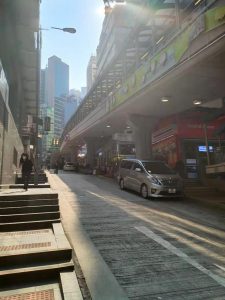
Pic 1: the Central-Mid-Levels escalator, Cochrane Street.
In the original film, four protagonists appeared on the sky bridge. The first is policeman 663, played by Tony Leung. At this time, his story has not yet begun. The camera only shows the “stranger” who is on duty. At the same moment, Takeshi Kaneshiro’s character Wu was running up the stairs because of a broken relationship, shouting, “Miura Yuka, I’m going to kill you!” The tone of the whole picture is cool, and the color is lake blue and pale. Slow shutter and hand-held lens make the whole picture blurred. At this moment, the flyover at night witnessed a young man who turned sadness into anger after being broken in love and vented on the idol his ex-girlfriend liked. At the same time, the flyover accommodated a boring working man.
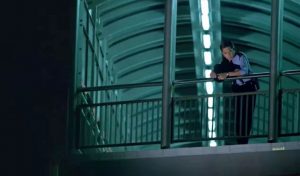
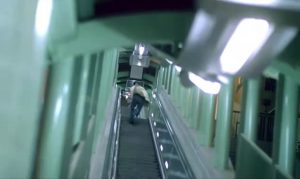
Pic 2: “Stranger” who is on duty. Chungking Express,1994, directed by Wong Kar-wai.
Pic 3: Wu was running up the stairs because of a broken relationship.Chungking Express,1994, directed by Wong Kar-wai.
In the discarded clips, the contrast of “different characters appearing in the same place” is more obvious. 663’s ex-girlfriend regretted after dumping 663, and she was squatting and crying on the overpass at night, who failed to reconcile. The dim lighting and the squatting posture further enhanced the atmosphere of “regret.” On the same night, Affi, played by Faye Wong, walked forward while eating noodles. She suddenly squatted down to see 663’s home (this took advantage of the unique location of the sky bridge). It was also at night, but the lights were as bright as during the day, and Affi’s yellow shirt was illuminated by the lights, highlighting Affi’s quirky temperament. The light also set off the atmosphere of “eager to see the person in her dream”.
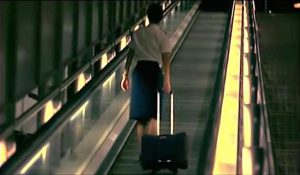

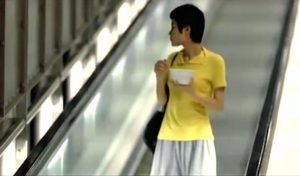
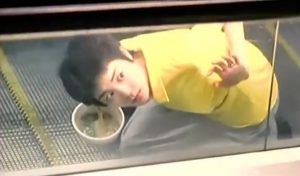
Pic 4&5: 663’s ex-girlfriend regretted after dumping 663. Chungking Express,1994, directed by Wong Kar-wai.
Pic 6& 7: Affi suddenly squatted down.Chungking Express,1994, directed by Wong Kar-wai.
Different characters appear in the same place, which highlights the high density of Hong Kong, this city, which matches the characteristics of the sky bridge-a “symbol of density.” As Wong Kar-wai said, this space seems to have become a witness. The flyover, in reality, is immutable. It is just a system that assists the normal operation of the city. As a person walking on the flyover, I almost completely ignore its existence and only think about my destination or just sigh how long it is. But in the movie, each character has stronger emotions. Because different people have different moods, the lights of the sky bridge become cold or warm. In the movie, the sky bridge is no longer just a system; and it is an emotional platform. Its density makes people in the city physically close, but because people’s moods are different, the sky bridges seem to pull them far away.
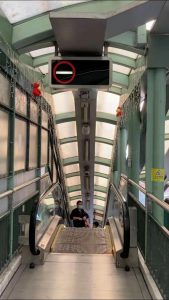

Pic 8 & 9: As a person walking on the flyover, I almost completely ignore its existence and only think about my destination.
Reference
The discarded clips of Chungking Express. https://www.bilibili.com/video/BV1sx411677s?from=search&seid=15185291731449262333
The Central–Mid-Levels escalator, Wikipedia. https://en.wikipedia.org/wiki/Central%E2%80%93Mid-Levels_escalator
——Mao Yue Yang 3035770549
The discussion on density is an ever timely one and I appreciate your attempt to reflect on density in Hong Kong. On this issue however, how the Central-Mid-levels escalator is a symbol of density remains rather vague in your analysis. It is not clear how the encounters of four different characters and their individual experiences on the escalator “symbolize density.” Important to the discussion would be to compare how the different characters use the space in the space and in reality. Are they typifying the urban encounters? How do their movements up and down it and the two women’s looking out from it reveals the problem of building density? In particular, consider the proximity of this infrastructure of mobility to the adjacent residential and commercial buildings and streets.
Offer insights from your fieldwork in reflection of how the space becomes “a witness.” How does it do that in the film and in reality? What is it a witness to? For whom does it bear witness? In your final paragraph, you mention how the lighting of the escalator is “an emotional platform,” seemingly analogous to how different individuals have different emotions and moods. How are these changes presented in the film and how does this occur in reality? What clues do the lighting of the escalator in which the film characters appear in the film tell you about the time of the day and the weather conditions? Why not conduct your field work during these times to draw upon first hand observations. Direct your analytical discussion more closely to your fieldwork findings and observations. How does the escalator affirm or challenges Auge’s analysis of transit spaces as non-places? Finally, avoid citing from general sources like Wikipedia but instead refer to primary sources and class readings such as in this case, Yoos, J. and V. James’ “The Multilevel Metropolis” in Places Journal (May 2016) (week 5 class reading).